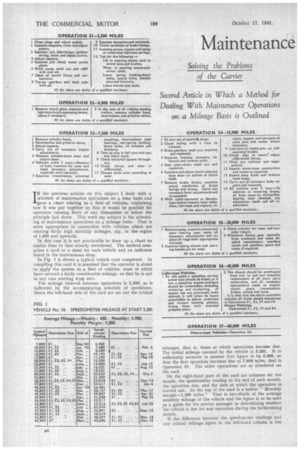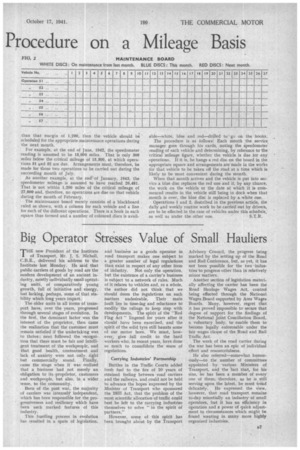Maintenance Procedure on a Mileage Basis
Page 24

Page 25

If you've noticed an error in this article please click here to report it so we can fix it.
IN the previous articles on this subject I dealt with a schedule of maintenance operations on a time basis and gave a chart relating to a fleet of vehicles, explaining how it was put together so that it would be possible for operators running fleets of any dimensions to follow the principle laid down. This week my subject is the scheduling of maintenance operations on a mileage basis. That is more appropriate in connection with vehicles which are running fairly high monthly mileages, say, in theregion of 1,600 and upwards.
In this case it is not practicable to draw up a chart on similar lines to that already mentioned. The method comprises a card or a sheet for each vehicle and an indicator board in the maintenance shop.
In Fig. 1 is shown a typical vehicle card completed. In .compiling this card it is assumed that the operator is about to apply the system to a fleet of vehicles, most of which have covered a fairly considerable mileage, so that he is not in any case starting from zero.
The mileage interval between operations is 2,500, as is indicated by the accompanying schedule of operations. Down the left-hand side of the card are set out the critical
mileages, that is, those at which operations become due. The initial mileage covered by the vehicle is 5,281. It is sufficiently accurate to assume that figure to be 5,300, so that the first operation becomes due at 7,800 miles, that is Operation 51. The other operations are as scheduled on the card, On the right-hand part of the card are columns for the month, the speedometer reading at the end of each month, the operation due, and the date at which the operation is carried out. At the top of the card is a notice: " Monthly margin-1,200 miles." That is two-thirds of the average monthly mileage of tha vehicle and the figure is to be used as a guide for the service manager in determining whether 'the vehicle is due for any operation during the forthcoming month.
If the difference between the speedometer readings and any critical mileage figure in the left-hand column is lees than that margin of 1,200, then the vehicle should be scheduled for the appropriate maintenance operations during the next month.
For example, at the end of June, 1942, the speedometer reading is assumed to be 15,000 miles. That is only 300 miles below the critical mileage of 15,300, at which operations 51 and 52 are due. Arrangements must, therefore, be made for those two operations to be carried out during the succeeding month of July, As another example, at the end of January, 1943, the speedometer mileageis assumed to have reached 25,481. That is not within 1,200 miles of the critical mileage of 27,800 and, therefore, no operations are due on that vehicle during the month of February.
The maintenance board merely consists of a blackboard ruled as shown, with a column for each vehicle and a line for each of the different operations. There is a hook in each square thus formed and a number of coloured discs is avail
able—white, blue and red—drilled to` go on the hooks.
The procedure is as follows: Each month the service manager goes through his cards, noting the speedometer reading of each vehicle and determining, by reference to the critical mileage figure, whether the vehicle is due for any operations. If it is, he hangs a red disc on the board in the appropriate square and arrangements are made in the works for that vehicle to be taken off the road at a time which is likely to be most convenient during the month.
When that month arrives and the vehicle is put into service a blue disc replaces the red one and if, by any chance, the work on the vehicle or the date at which it is commenced results in the vehicle still being in dock when that month is over, the blue disc is replaced by a white one.
Operations I and 2, described in the previous article, the daily and weekly routine work to he carried out by drivers, are to be effected in the case of vehicles under this schedule, as well as under the other one,
S. T R




















































